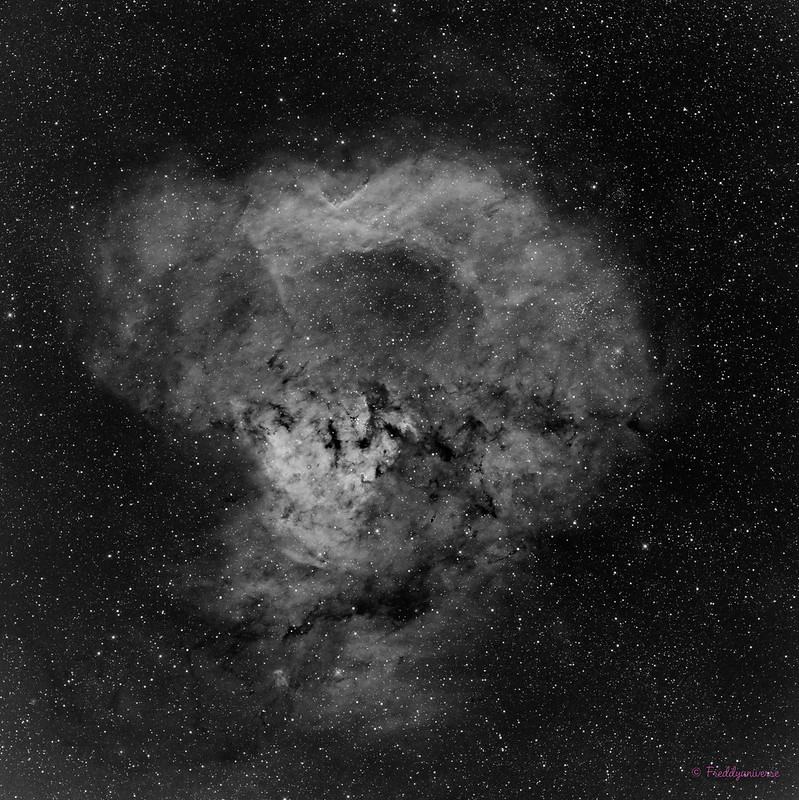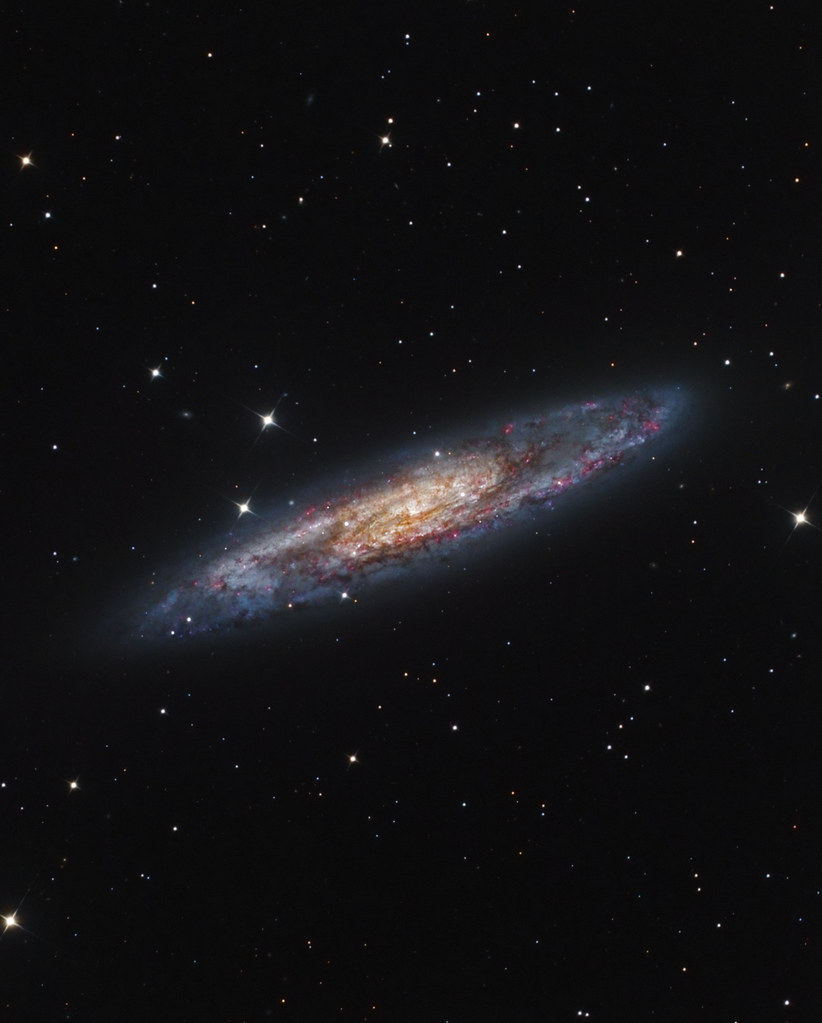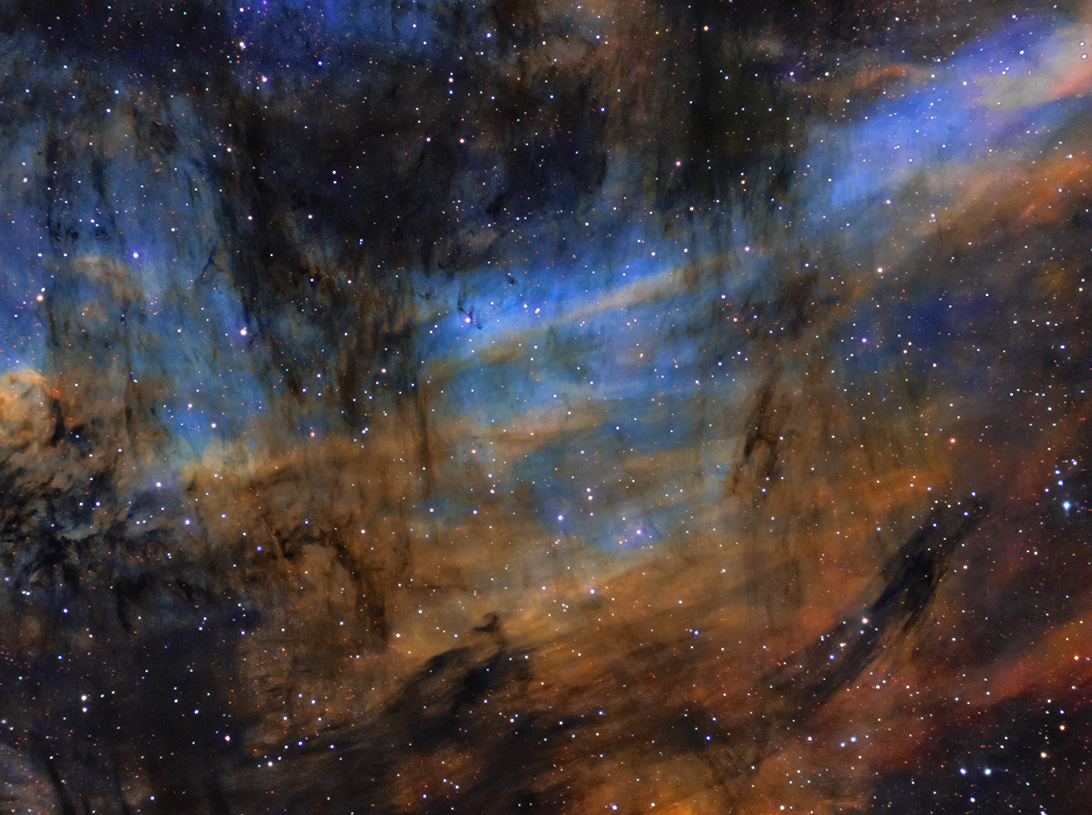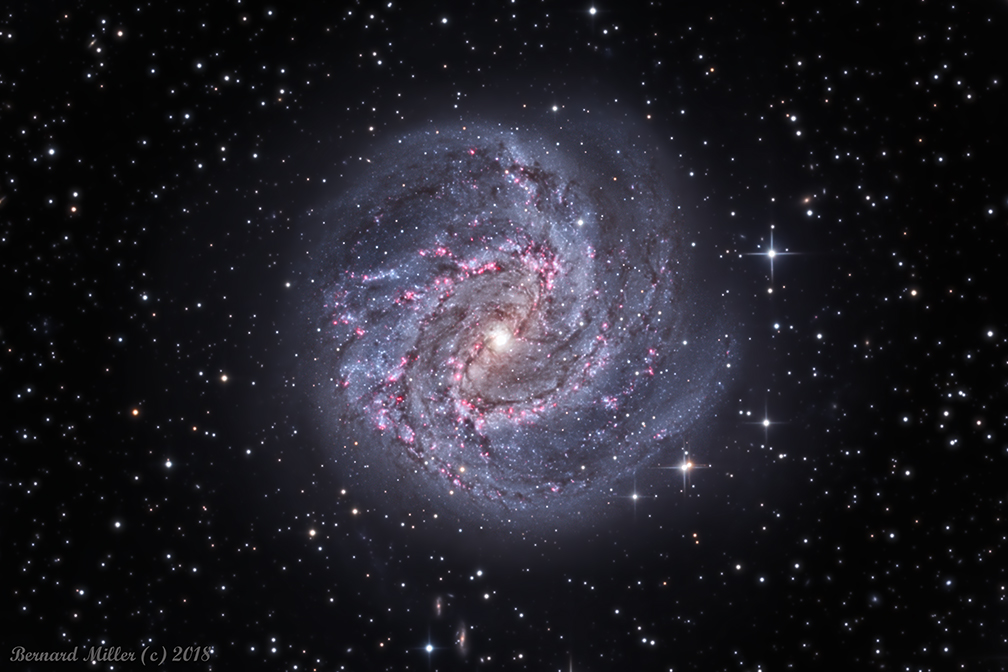Submission: 2018 October
-
G.Chatzifrantzis
- Ensign
- Posts: 29
- Joined: Wed Nov 01, 2017 12:46 pm
Re: Submission: 2018 October
NGC 891 Edge On Galaxy
Equipment :
OTA : Meade 14 SCT - C11 Xlt
Mount : Skywatcher EQ8 - Neq6 pro
Camera : Atik 460ex & exc
Filters : Astronomik CLS,Idas P2
Guiding : OAG via Lodestar X2
Exposure :
RGB : 2h (460exc & C11)
L : 4h30m (460ex & M14)
Location : Greece
Equipment :
OTA : Meade 14 SCT - C11 Xlt
Mount : Skywatcher EQ8 - Neq6 pro
Camera : Atik 460ex & exc
Filters : Astronomik CLS,Idas P2
Guiding : OAG via Lodestar X2
Exposure :
RGB : 2h (460exc & C11)
L : 4h30m (460ex & M14)
Location : Greece
-
Manel Martín Folch
- Ensign
- Posts: 15
- Joined: Tue Jan 10, 2017 7:13 pm
-
Freddyuniverse
- Ensign
- Posts: 19
- Joined: Tue Jul 24, 2018 11:15 pm
Re: Submission: 2018 October
Skull of Ape NGC7822
5H 27Min Exposition (LHRGB)
Moravian G4 16000
Takahashi Epsilon 180 EDC
https://www.freddyuniverse.com/galeria- ... nebulosas/
www.freddyuniverse.com
Copyright: Alfredo Sayalero, Freddyuniverse
 Skull of Ape- by Freddy S., en Flickr
Skull of Ape- by Freddy S., en Flickr
 Skull of Ape Ha by Freddy S., en Flickr
Skull of Ape Ha by Freddy S., en Flickr
5H 27Min Exposition (LHRGB)
Moravian G4 16000
Takahashi Epsilon 180 EDC
https://www.freddyuniverse.com/galeria- ... nebulosas/
www.freddyuniverse.com
Copyright: Alfredo Sayalero, Freddyuniverse
 Skull of Ape- by Freddy S., en Flickr
Skull of Ape- by Freddy S., en Flickr Skull of Ape Ha by Freddy S., en Flickr
Skull of Ape Ha by Freddy S., en FlickrRe: Submission: 2018 October
Last edited by bystander on Tue Oct 09, 2018 3:03 am, edited 1 time in total.
Reason: Please, no hotlinks to images > 500Kb. Substituted smaller image.
Reason: Please, no hotlinks to images > 500Kb. Substituted smaller image.
-
strongmanmike
NGC 253
The southern king of nearby galaxies
Large size image here: http://www.pbase.com/strongmanmike2002/ ... 5/original
Copyright: Michael Sidonio
Large size image here: http://www.pbase.com/strongmanmike2002/ ... 5/original
Copyright: Michael Sidonio
Re: Submission: 2018 October
Comet 21P / Giacobini-Zinner on October 9th
near IC 2177 (Seagull Nebula) and open cluster NGC 2335
Copyright: Velimir Popov, Emil Ivanov Irida Observatory More info and hi-res images on website
near IC 2177 (Seagull Nebula) and open cluster NGC 2335
Copyright: Velimir Popov, Emil Ivanov Irida Observatory More info and hi-res images on website
Re: Submission: 2018 October
-
Guest
IC 5068 - Hubble Palette
IC 5068
Copyright: Donald Waid
IC 5068 is an area of relatively faint emission nebula in the constellation Cygnus the Swan approximately 1600 light-years from the Earth. It is located just south of the more famous, and frequently imaged, Pelican and North American nebulae. The bright central portion of the image carries the designation IC 5068. The nebulosity to right and left side of IC 5068 are designated LBN 329 and 332. The dark vertical bands of obscuring dust separate them from IC 5068
Imaging details and description may be view at the link below:
http://www.waid-observatory.com/IC5068- ... 01-NB.html
(Click on the displayed images to progress to higher resolutions.)
Copyright: Donald Waid
IC 5068 is an area of relatively faint emission nebula in the constellation Cygnus the Swan approximately 1600 light-years from the Earth. It is located just south of the more famous, and frequently imaged, Pelican and North American nebulae. The bright central portion of the image carries the designation IC 5068. The nebulosity to right and left side of IC 5068 are designated LBN 329 and 332. The dark vertical bands of obscuring dust separate them from IC 5068
Imaging details and description may be view at the link below:
http://www.waid-observatory.com/IC5068- ... 01-NB.html
(Click on the displayed images to progress to higher resolutions.)
Re: Submission: 2018 October
Comet over nebula
Comet Giacobini-Zinner on 10.10.2018 "over" IC 2177 (Seagull Nebula)
Copyright: Velimir Popov, Emil Ivanov Irida Observatory More info and hi-res images on website
Comet Giacobini-Zinner on 10.10.2018 "over" IC 2177 (Seagull Nebula)
Copyright: Velimir Popov, Emil Ivanov Irida Observatory More info and hi-res images on website
-
KuriousGeorge
- Science Officer
- Posts: 218
- Joined: Wed Dec 30, 2015 7:07 am
- Location: San Diego, CA
- Contact:
Re: Submission: 2018 October
NGC 7497. KG Observatory, Julian, CA.
NGC 7497, 60 million light years distant, appears behind this interstellar dust less than a thousand light years distant. This dust is very dimly lit by the combined starlight of our own Milky Way galaxy.
This dim starlight reflection was captured at 4,200' with 11.25 hours of luminance and 6 hours of color (RGB) using a 24" Planewave CDK24.
During the 3 days it took to gather the light shown here, the skies were exceptionally dark (21.4 SQM average) and clear.
NGC 7497, 60 million light years distant, appears behind this interstellar dust less than a thousand light years distant. This dust is very dimly lit by the combined starlight of our own Milky Way galaxy.
This dim starlight reflection was captured at 4,200' with 11.25 hours of luminance and 6 hours of color (RGB) using a 24" Planewave CDK24.
During the 3 days it took to gather the light shown here, the skies were exceptionally dark (21.4 SQM average) and clear.
-
Hermann von Eiff
- Ensign
- Posts: 43
- Joined: Mon Sep 26, 2016 5:48 pm
Re: Submission: 2018 October
Dear KuriousGeorge,
this is a REALLY GREAT image of the galaxy and its surroundings! Congratulations!
Hermann von Eiff
this is a REALLY GREAT image of the galaxy and its surroundings! Congratulations!
Hermann von Eiff
-
PatrickWinkler
- Ensign
- Posts: 82
- Joined: Wed May 25, 2016 4:24 pm
- Location: Traiskirchen (Austria)
- Contact:
-
PatrickWinkler
- Ensign
- Posts: 82
- Joined: Wed May 25, 2016 4:24 pm
- Location: Traiskirchen (Austria)
- Contact:
Re: Submission: 2018 October
NGC 896, 46 Hours
H 34x1800" bin 1x1
OIII: 31x1800" bin 1x1
SII: 27x1800" bin 1x1
RCOS 14.5
Paramount ME
@DeepSkyWest
H 34x1800" bin 1x1
OIII: 31x1800" bin 1x1
SII: 27x1800" bin 1x1
RCOS 14.5
Paramount ME
@DeepSkyWest
Re: Submission: 2018 October
NGC 206 (see center of image). RGB + Luminance. 0.93"/pixel image scale.

High resolution at: https://peternagy.smugmug.com/Telescope ... -jQJFt62/A
Astrodon I series Red filter, 18 x 4 minutes, 1x1. 10/12/2018.
Astrodon I series Green filter, 18 x 4 minutes, 1x1. 10/12/2018.
Astrodon I series Blue filter, 18 x 4 minutes, 1x1. 10/12/2018.
Astrodon I series Lum filter, 54 x 4 minutes, 1x1. 10/12/2018.
Total 7.2 hours.
TEC 140 APO F/7 with TEC Field Flattener, Astro-Physics A-P1100GTO GEM with absolute encoders. QSI660wsg. OAG and Ultrastar autoguider (1.31"/sec), Optec Handy Stepper Motor focuser.
Captured and automated with SGP. Calibration and Post-processed with PixInsight. PHD2 settings: RA Aggressiveness: 60, RA Hysteresis: 10, Max RA/Dec Duration: 2000, Min Move: 0.60 (0.8" guide camera), Calibration Steps: 300msec, Auto/Resist Switching, Auto guiding exposure and extreme dithering.

High resolution at: https://peternagy.smugmug.com/Telescope ... -jQJFt62/A
Astrodon I series Red filter, 18 x 4 minutes, 1x1. 10/12/2018.
Astrodon I series Green filter, 18 x 4 minutes, 1x1. 10/12/2018.
Astrodon I series Blue filter, 18 x 4 minutes, 1x1. 10/12/2018.
Astrodon I series Lum filter, 54 x 4 minutes, 1x1. 10/12/2018.
Total 7.2 hours.
TEC 140 APO F/7 with TEC Field Flattener, Astro-Physics A-P1100GTO GEM with absolute encoders. QSI660wsg. OAG and Ultrastar autoguider (1.31"/sec), Optec Handy Stepper Motor focuser.
Captured and automated with SGP. Calibration and Post-processed with PixInsight. PHD2 settings: RA Aggressiveness: 60, RA Hysteresis: 10, Max RA/Dec Duration: 2000, Min Move: 0.60 (0.8" guide camera), Calibration Steps: 300msec, Auto/Resist Switching, Auto guiding exposure and extreme dithering.
-
KuriousGeorge
- Science Officer
- Posts: 218
- Joined: Wed Dec 30, 2015 7:07 am
- Location: San Diego, CA
- Contact:
Re: Submission: 2018 October
IC 239 is about 40 million light years distant. Its low surface brightness may indicate that this galaxy isn't as massive as many others of the same type (e.g., M101).
The bright foreground stars of our own galaxy make imaging this faint galaxy a bit challenging. To help I used 5 minute subs for luminance and 15 minute subs for color.
The bright foreground stars of our own galaxy make imaging this faint galaxy a bit challenging. To help I used 5 minute subs for luminance and 15 minute subs for color.
Re: Submission: 2018 October
Sharpless 2-188, planetary nebula in Cassiopeia
High resolution image and technical data: http://www.javierlaina.es/IMAGENES/SH2_188.html
http://www.javierlaina.es/IMAGENES/SH2_188.jpg
Javier Gómez Laina (Spain)
http://www.javierlaina.es/indexeng.html
High resolution image and technical data: http://www.javierlaina.es/IMAGENES/SH2_188.html
http://www.javierlaina.es/IMAGENES/SH2_188.jpg
Javier Gómez Laina (Spain)
http://www.javierlaina.es/indexeng.html
Last edited by bystander on Sun Oct 14, 2018 2:54 pm, edited 1 time in total.
Reason: Please, no hotlinks to images > 500Kb.
Reason: Please, no hotlinks to images > 500Kb.
Re: Submission: 2018 October
This is a delightful portrait of about a third of the Andromeda galaxy, centered on the bright region of star formation, NGC 206. Note how the "texture" of the stellar populations change with the color of them, and note how the stellar populations are divided by thick dust lanes in Andromeda. To the left of the great dark U-shaped dust lane at left, bright blue stars dominate the light output, making the stellar populations blue and "prickly like hedgehogs". To the right of the U-shaped dust lane, stellar populations are bluish beige, pure beige or yellowish beige, and they are mostly perfectly smooth.topboxman wrote: ↑Sat Oct 13, 2018 11:01 pm NGC 206 (see center of image). RGB + Luminance. 0.93"/pixel image scale.
High resolution at: https://peternagy.smugmug.com/Telescope ... -jQJFt62/A
Astrodon I series Red filter, 18 x 4 minutes, 1x1. 10/12/2018.
Astrodon I series Green filter, 18 x 4 minutes, 1x1. 10/12/2018.
Astrodon I series Blue filter, 18 x 4 minutes, 1x1. 10/12/2018.
Astrodon I series Lum filter, 54 x 4 minutes, 1x1. 10/12/2018.
Total 7.2 hours.
TEC 140 APO F/7 with TEC Field Flattener, Astro-Physics A-P1100GTO GEM with absolute encoders. QSI660wsg. OAG and Ultrastar autoguider (1.31"/sec), Optec Handy Stepper Motor focuser.
Captured and automated with SGP. Calibration and Post-processed with PixInsight. PHD2 settings: RA Aggressiveness: 60, RA Hysteresis: 10, Max RA/Dec Duration: 2000, Min Move: 0.60 (0.8" guide camera), Calibration Steps: 300msec, Auto/Resist Switching, Auto guiding exposure and extreme dithering.
Beautiful!
Ann
Color Commentator
Re: Submission: 2018 October
This is a delightful portrait of a delicate spiral galaxy. Note the elegance and the numerous pink nebulas of star formation in the spiral arms and the faintness and the weak bar of the central region.KuriousGeorge wrote: ↑Sun Oct 14, 2018 6:27 am IC 239 is about 40 million light years distant. Its low surface brightness may indicate that this galaxy isn't as massive as many others of the same type (e.g., M101).
The bright foreground stars of our own galaxy make imaging this faint galaxy a bit challenging. To help I used 5 minute subs for luminance and 15 minute subs for color.
Ann
Color Commentator
Re: Submission: 2018 October
Thank you Ann. It was a pleasure imaging this DSO and processing was a challenge.Ann wrote: ↑Sun Oct 14, 2018 10:44 amThis is a delightful portrait of about a third of the Andromeda galaxy, centered on the bright region of star formation, NGC 206. Note how the "texture" of the stellar populations change with the color of them, and note how the stellar populations are divided by thick dust lanes in Andromeda. To the left of the great dark U-shaped dust lane at left, bright blue stars dominate the light output, making the stellar populations blue and "prickly like hedgehogs". To the right of the U-shaped dust lane, stellar populations are bluish beige, pure beige or yellowish beige, and they are mostly perfectly smooth.topboxman wrote: ↑Sat Oct 13, 2018 11:01 pm NGC 206 (see center of image). RGB + Luminance. 0.93"/pixel image scale.
High resolution at: https://peternagy.smugmug.com/Telescope ... -jQJFt62/A
Astrodon I series Red filter, 18 x 4 minutes, 1x1. 10/12/2018.
Astrodon I series Green filter, 18 x 4 minutes, 1x1. 10/12/2018.
Astrodon I series Blue filter, 18 x 4 minutes, 1x1. 10/12/2018.
Astrodon I series Lum filter, 54 x 4 minutes, 1x1. 10/12/2018.
Total 7.2 hours.
TEC 140 APO F/7 with TEC Field Flattener, Astro-Physics A-P1100GTO GEM with absolute encoders. QSI660wsg. OAG and Ultrastar autoguider (1.31"/sec), Optec Handy Stepper Motor focuser.
Captured and automated with SGP. Calibration and Post-processed with PixInsight. PHD2 settings: RA Aggressiveness: 60, RA Hysteresis: 10, Max RA/Dec Duration: 2000, Min Move: 0.60 (0.8" guide camera), Calibration Steps: 300msec, Auto/Resist Switching, Auto guiding exposure and extreme dithering.
Beautiful!
Ann
Peter
Re: Submission: 2018 October
This is an image of M83, also known as the Southern Pinwheel Galaxy due to its resemblance to the Pinwheel Galaxy (M101). It is a barred spiral galaxy about 15 million light years away in the constellation Hydra. It is one of the closest and brightest barred spiral galaxies in the sky and is visible with binoculars
-
-Amenophis-
- Ensign
- Posts: 21
- Joined: Mon Oct 15, 2018 2:42 pm
Re: Submission: 2018 October
NGC 7822 (Narrowband)
NGC 7822 is a young star forming complex in the constellation of Cepheus. The complex encompasses the emission region designated Sharpless 171, and the young cluster of stars named Berkeley 59. The complex is believed to be some 800-1000 pc distant, with the younger components aged no more than a few million years.The complex also includes one of the hottest stars discovered within 1 kpc of the Sun, namely BD+66 1673, which is an eclipsing binary system consisting of an O5V that exhibits a surface temperature of nearly 45000 K and a luminosity ~100,000 times that of the Sun. The star is one of the primary sources illuminating the nebula and shaping the complex's famed pillars of creation-type formations, the elephant trunks.
Credits : Thomas LELU
Wenton telescope ASA 10"
Moravian CCD G2-4000
Paramount MyT
SII : 35x900s
Ha : 65x900s
OIII : 32x900s
Total exposure : 33 hrs

NGC 7822 is a young star forming complex in the constellation of Cepheus. The complex encompasses the emission region designated Sharpless 171, and the young cluster of stars named Berkeley 59. The complex is believed to be some 800-1000 pc distant, with the younger components aged no more than a few million years.The complex also includes one of the hottest stars discovered within 1 kpc of the Sun, namely BD+66 1673, which is an eclipsing binary system consisting of an O5V that exhibits a surface temperature of nearly 45000 K and a luminosity ~100,000 times that of the Sun. The star is one of the primary sources illuminating the nebula and shaping the complex's famed pillars of creation-type formations, the elephant trunks.
Credits : Thomas LELU
Wenton telescope ASA 10"
Moravian CCD G2-4000
Paramount MyT
SII : 35x900s
Ha : 65x900s
OIII : 32x900s
Total exposure : 33 hrs

-
-Amenophis-
- Ensign
- Posts: 21
- Joined: Mon Oct 15, 2018 2:42 pm
Re: Submission: 2018 October
Sh2-187
The cloud is part of a large molecular complex at the center of which is a high-speed molecular beam from a source of infrared radiation labeled S 187 IRS, located very close to another powerful source, IRAS 01202 + 6133.
The visible part of the cloud is surrounded by a neutral hydrogen envelope, detectable at wavelengths other than visible, whose total mass can be estimated at about 7,600 solar masses.
His age can be estimated at around 100-200 000 years old. The distance was estimated by spectrophotometry around 1440 parsecs (about 4700 light-years).
Evidence of the presence of star formation phenomena can be identified in the numerous infrared sources discovered in the nebula, such as those just mentioned, in particular the molecular beam; in particular, one of the most powerful sources is IRAS 01202 + 6133.
Credits : Thomas LELU
Telescope ASA10''
Moravian G2-4000
Paramount MyT
Filtre Astrodon Luminance : 139x300s
Filtre Astrodon RED : 23x300s
Filtre Astrodon GREEN : 25x300s
Filtre Astrodon BLUE : 20x300s
Total : 17hrs

The cloud is part of a large molecular complex at the center of which is a high-speed molecular beam from a source of infrared radiation labeled S 187 IRS, located very close to another powerful source, IRAS 01202 + 6133.
The visible part of the cloud is surrounded by a neutral hydrogen envelope, detectable at wavelengths other than visible, whose total mass can be estimated at about 7,600 solar masses.
His age can be estimated at around 100-200 000 years old. The distance was estimated by spectrophotometry around 1440 parsecs (about 4700 light-years).
Evidence of the presence of star formation phenomena can be identified in the numerous infrared sources discovered in the nebula, such as those just mentioned, in particular the molecular beam; in particular, one of the most powerful sources is IRAS 01202 + 6133.
Credits : Thomas LELU
Telescope ASA10''
Moravian G2-4000
Paramount MyT
Filtre Astrodon Luminance : 139x300s
Filtre Astrodon RED : 23x300s
Filtre Astrodon GREEN : 25x300s
Filtre Astrodon BLUE : 20x300s
Total : 17hrs

-
-Amenophis-
- Ensign
- Posts: 21
- Joined: Mon Oct 15, 2018 2:42 pm
Re: Submission: 2018 October
French Heart
Cosmic clouds form fantastic shapes in the central regions of emission nebula IC 1805. The clouds are sculpted by stellar winds and radiation from massive hot stars in the nebula's newborn star cluster, Melotte 15. About 1.5 million years young, the cluster stars are scattered in this colorful skyscape, along with dark dust clouds in silhouette against glowing atomic gas. A composite of narrowband and broadband telescopic images, the view spans about 15 light-years and includes emission from ionized hydrogen, sulfur, and oxygen atoms mapped to green, red, and blue hues in the popular Hubble Palette. Wider field images reveal that IC 1805's simpler, overall outline suggests its popular name - The Heart Nebula. IC 1805 is located about 7,500 light years away toward the boastful constellation Cassiopeia.
Credits : Thomas LELU
Telescope ASA10 »
Moravian G2-4000
Paramount MyT
Ha : 36x900s
OIII : 38x900s
SII : 39x900s
Total exposure : 33hrs

Cosmic clouds form fantastic shapes in the central regions of emission nebula IC 1805. The clouds are sculpted by stellar winds and radiation from massive hot stars in the nebula's newborn star cluster, Melotte 15. About 1.5 million years young, the cluster stars are scattered in this colorful skyscape, along with dark dust clouds in silhouette against glowing atomic gas. A composite of narrowband and broadband telescopic images, the view spans about 15 light-years and includes emission from ionized hydrogen, sulfur, and oxygen atoms mapped to green, red, and blue hues in the popular Hubble Palette. Wider field images reveal that IC 1805's simpler, overall outline suggests its popular name - The Heart Nebula. IC 1805 is located about 7,500 light years away toward the boastful constellation Cassiopeia.
Credits : Thomas LELU
Telescope ASA10 »
Moravian G2-4000
Paramount MyT
Ha : 36x900s
OIII : 38x900s
SII : 39x900s
Total exposure : 33hrs







